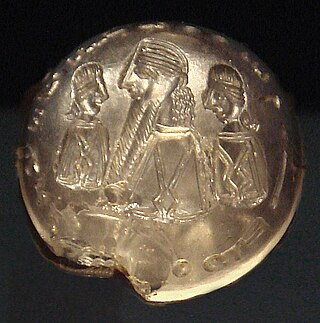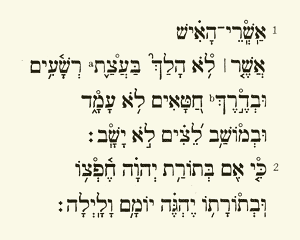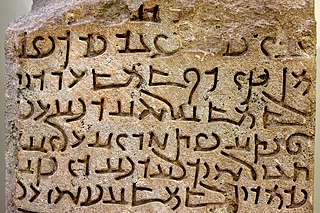
The ancient Aramaic alphabet was used to write the Aramaic languages spoken by ancient Aramean pre-Christian tribes throughout the Fertile Crescent. It was also adopted by other peoples as their own alphabet when empires and their subjects underwent linguistic Aramaization during a language shift for governing purposes — a precursor to Arabization centuries later — including among the Assyrians and Babylonians who permanently replaced their Akkadian language and its cuneiform script with Aramaic and its script, and among Jews, who adopted the Aramaic language as their vernacular and started using the Aramaic alphabet even for writing Hebrew, displacing the former Paleo-Hebrew alphabet.

Manichaeism is a former major world religion, founded in the 3rd century CE by the Parthian prophet Mani, in the Sasanian Empire.

The Syriac alphabet is a writing system primarily used to write the Syriac language since the 1st century AD. It is one of the Semitic abjads descending from the Aramaic alphabet through the Palmyrene alphabet, and shares similarities with the Phoenician, Hebrew, Arabic and Sogdian, the precursor and a direct ancestor of the traditional Mongolian scripts.

The Sogdian alphabet was originally used for the Sogdian language, a language in the Iranian family used by the people of Sogdia. The alphabet is derived from Syriac, a descendant script of the Aramaic alphabet. The Sogdian alphabet is one of three scripts used to write the Sogdian language, the others being the Manichaean alphabet and the Syriac alphabet. It was used throughout Central Asia, from the edge of Iran in the west, to China in the east, from approximately 100–1200 A.D.

Middle Persian or Pahlavi, also known by its endonym Pārsīk or Pārsīg in its later form, is a Western Middle Iranian language which became the literary language of the Sasanian Empire. For some time after the Sasanian collapse, Middle Persian continued to function as a prestige language. It descended from Old Persian, the language of the Achaemenid Empire and is the linguistic ancestor of Modern Persian, an official language of Iran, Afghanistan (Dari) and Tajikistan (Tajik).
The Sogdian language was an Eastern Iranian language spoken mainly in the Central Asian region of Sogdia, located in modern-day Uzbekistan, Tajikistan, Kazakhstan and Kyrgyzstan; it was also spoken by some Sogdian immigrant communities in ancient China. Sogdian is one of the most important Middle Iranian languages, along with Bactrian, Khotanese Saka, Middle Persian, and Parthian. It possesses a large literary corpus.
Frahang-ī Pahlavīg is the title of an anonymous dictionary of mostly Aramaic logograms with Middle Persian translations and transliterations. Its date is unknown.

The Avestan alphabet is a writing system developed during Iran's Sasanian era (226–651 CE) to render the Avestan language.

Pahlavi is a particular, exclusively written form of various Middle Iranian languages. The essential characteristics of Pahlavi are:

In a right-to-left, top-to-bottom script, writing starts from the right of the page and continues to the left, proceeding from top to bottom for new lines. Arabic, Hebrew, and Persian are the most widespread RTL writing systems in modern times.

Asoristan was the name of the Sasanian province of Assyria and Babylonia from 226 to 637.

Imperial Aramaic is a linguistic term, coined by modern scholars in order to designate a specific historical variety of Aramaic language. The term is polysemic, with two distinctive meanings, wider (sociolinguistic) and narrower (dialectological). Since most surviving examples of the language have been found in Egypt, the language is also referred to as Egyptian Aramaic.

Walter Bruno Henning was a German scholar of Middle Iranian languages and literature, especially of the corpus discovered by the Turpan expeditions of the early 20th century.
The Old Uyghur alphabet was a Turkic script used for writing the Old Uyghur, a variety of Old Turkic spoken in Turpan and Gansu that is the ancestor of the modern Western Yugur language. The term "Old Uyghur" used for this alphabet is misleading because Qocho, the Uyghur (Yugur) kingdom created in 843, originally used the Old Turkic alphabet. The Uyghur adopted this "Old Uyghur" script from local inhabitants when they migrated into Turfan after 840. It was an adaptation of the Aramaic alphabet used for texts with Buddhist, Manichaean and Christian content for 700–800 years in Turpan. The last known manuscripts are dated to the 18th century. This was the prototype for the Mongolian and Manchu alphabets. The Old Uyghur alphabet was brought to Mongolia by Tata-tonga.

Mar Ammo was a 3rd-century Manichean disciple of the prophet Mani. According to Manichaen tradition he spread Manichaeism eastward into Sogdiana during the time period when Mani was living. Mar Ammo is well known as the apostle of the east in Manichean literature nevertheless his exact origins are unknown. His Syriac name may denote that he was Syrian in origin. However, a Parthian origin may also be seen and is mentioned by some scholars, especially due to his outstanding role in establishing the Parthian language as the official language of the eastern Manichean Church, later to be replaced by Sogdian in the sixth century. Furthermore, Mar Ammo is widely regarded as the composer of the Manichaean Parthian hymn-cycles.

Aramaic of Hatra, Hatran Aramaic or Ashurian designates a Middle Aramaic dialect, that was used in the region of Hatra and Assur in northeastern parts of Mesopotamia, approximately from the 3rd century BC to the 3rd century CE. Its range extended from the Nineveh Plains in the centre, up to Tur Abdin in the north, Dura-Europos in the west and Tikrit in the south.
Portions of the Bible were translated into the Sogdian language in the 9th and 10th centuries. All surviving manuscripts are incomplete Christian liturgical texts, intended for reading on Sundays and holy days. It is unknown if a whole translation of any single book of the Bible was made, although the text known as C13 may be a fragment of a complete Gospel of Matthew. All but one text are written in Syriac script; only a few pages of the Book of Psalms written in Sogdian script are extant.
Manichaean scripture includes nine main books: the Seven Treatises of Manichaeism, all personally written by Mani in Syriac, the Shabuhragan written by Mani in Middle Persian, and the Arzhang, a series of illustrations painted by Mani.

In Manichaeism, Zarathustra is considered one of the four prophets of the faith, along with Buddha, Jesus and Mani. Mani believed that the teachings of Gautama Buddha, Zarathustra, and Jesus were incomplete, and that his revelations were for the entire world, calling his teachings the "Religion of Light".















